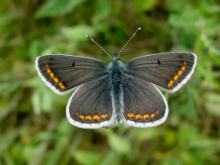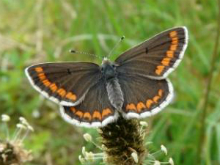
| Butterfly Conservation |
 |
| Hertfordshire & Middlesex Branch |
 |
|
|||
| Saving butterflies, moths and our environment | ||||


Brown ArgusAricia agesthisWidely distributed Distribution and Status The Brown Argus is widespread and fairly common in the two counties. In the 1980s colonies were found in only the chalky areas of northern Hertfordshire. Partly because of climate change the butterfly has adapted to colonise new sites containing alternative foodplants such as Doves-foot Cranesbill Geranium molle. There was an expansion in the 1990s in both range and abundance undoubtedly helped by the warm and dry summers in the middle of that decade although populations have declined slightly since then until 2017 when there was a resurgence which continued more spectacularly in the warm summer of 2018 Habitat Requirements Chalk grasslands and woodland rides but the recent expansion in range has seen it spread to other habitat types like gravel pits, roadside verges and field edges. It prefers short turf in sunny situations Larval Foodplants Common Stork's-bill Erodium cicutarium, Dove's-foot Cranesbill G. molle. Adult Food Sources Common Ragwort Senecio jacobaea, Wild Marjoram Origanum vulgare, Common Fleabane Pulicaria dysenterica Behaviour/Observation notes This species usually flies close to the ground and enjoys basking on sunny bare patches or on grass stems. As noted in the account for the Common Blue this species can be confused with the female Common Blue if the latter has minimal blue scales on its wings. The undersides of the Brown Argus differ in the spotting pattern in two ways: 1) the white-ringed black spot on the forewings near the body is absent and 2) the pair of spots nearest the inner edge of the hindwings is closer together which constitutes almost like a figure '8'. Good photographic opportunities can be obtained early in the morning when a number of individuals roost on tall grasses along with Common Blues Life History The Brown Argus is a bi-voltine species (May and early June, and again in late July and August) with the second generation nearly always found in greater numbers. Eggs are laid singly on the underside of a leaf of the foodplant. Larvae eat the underside of the leaves resulting in visible patches seen from above and are often attended to by ants. Pupae are formed on the base of the foodplant but sometimes they are buried in ant hills. It overwinters in the larval stage Further information
UK distribution map References
James, Trevor J.(2009), Flora of Hertfordshire,, Hertfordshire Natural History Society, Welwyn Garden City |
Copyright Butterfly Conservation © 2019 Hertfordshire & Middlesex Branch
Privacy and Copyright Statement and Cookie Policy Statement
Butterfly Conservation
Company limited by guarantee, registered in England (2206468)
Registered Office: Manor Yard, East Lulworth, Wareham, Dorset, BH20 5QP. Tel: 01929 400 209
Charity registered in England & Wales (254937) and in Scotland (SCO39268). VAT No. GB 991 2771 89